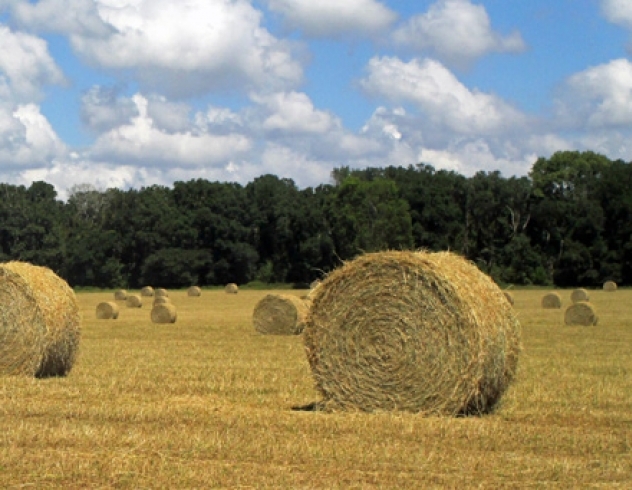News & Events

Crop Corner – Making the Most of “Making Hay”
June 01, 2016

First cutting has begun in earnest around the countryside. High quality forages start with good management, paying attention to crop stage and harvest techniques.
A high quality forage crop requires a good fertility program. Alfalfa is able to fixate its own nitrogen from the atmosphere, but it requires adequate P and K for maximum yield. For each ton of yield, a hay crop requires 30lbs of MAP and 100lbs of K. Average yields in Haldimand-Niagara can range from 2.5tons to 4tons for a highly productive alfalfa stand. A 4 ton crop would require 115lbs of MAP and 400lbs of potash per acre.
As the forage crop matures from early vegetative to flowering it will increase in fibre content and lose digestibility and feed value. Protein levels are highest when forage plants are young, once the plants start to form flower buds levels start to drop. Feed value will decline by 0.2% per day in crude protein and 0.4% per day in digestibility once alfalfa buds appear. Short cutting intervals, where forage is harvested when it is young will result in high quality forage, but will put added stress on the plant which can reduce persistency of the stand.
Attention should be paid to harvest techniques so that loses are minimized and forage quality is maintained. Once cut, hay cannot be made any better, its quality can only be maintained. Feed value declines after the plant has been cut because the plant is still respiring. Plant respiration is the process where sugars and starch are turned into energy. This process continues until the moisture level in the plant drops below 40%. Since a freshly cut plant has a moisture content around 80%, respiration continues for some time after cutting. Moisture is lost through the stomates in the plant leaves, these stomates are only open in the light. When hay is laid in a narrow thick swath, many of the stomates are closed and drying is slowed. By laying your windrow in a wide swath you can speed up drying and keep the sugars in your hay. A wide swath can also result in a lower ash content because a wide fluffy swath is held up by the stubble and doesn’t touch the ground.
Time of day can affect the sugar composition of forage. During the day plants accumulate sugars in their leaves. By cutting in the afternoon producers can harvest forages higher in sugars. However, attention should be paid to not cut too late into the afternoon because if the forage is still respiring when night falls, the stomates will close and respiration will continue resulting in quality losses.
Tedding or raking can speed up drying time of hay. Tedding is best done within 24 hours of cutting, or before the crop reaches 40% moisture to minimize leaf losses. Tedding the hay results in an evenly distributed swath for quick drying. Raking helps to expose the wet underside of swaths to dry. When raking the swath should not be much drier than 40% moisture or leaf loss can be severe.
High quality forages are achievable this year with a little management and thought. A good fertility program, cutting at the proper time, laying the hay in wide swaths, and minimizing leaf losses are steps to take to ensure that your forage crop is the highest quality that it can be.

This Crop Corner has been written by Elliott Armstrong, Sales Agronomist at Clark Agri Service. Elliott can be reached by email earmstrong@clarkagriservice.com or by phone 905-981-0045